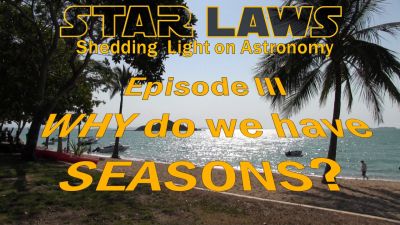 Why do we have seasons?
Why do we have seasons?
Why is it the case that when it’s summer in the Northern Hemisphere, it’s winter in the Southern Hemisphere (and vice versa)?
What time of year does the Southern Hemisphere get its longest days?
Where are the Tropics and why is it always hot there?
Why is it always cold at the North Pole and at the South Pole?
Here’s a short excerpt: EXCERPT COMING SOON
 The STAR LAWS Episode III Question Sheet for Students:
The STAR LAWS Episode III Question Sheet for Students:
![]() The PDF version.
The PDF version. ![]()
Google The Google Doc version. Google
![]() The Microsoft Word version.
The Microsoft Word version.![]()
![]() If you have ClickView, watch the whole episode here.
If you have ClickView, watch the whole episode here.
![]() If you have Learn360, watch the whole episode here.
If you have Learn360, watch the whole episode here.
Transcript:




The word astronomy comes from the Greek words astron which means star and nomos which means “law”. Astron nomy therefore translates literally as STAR LAWS. Astronomy is the study of the laws of nature that govern how stars and other bodies in space appear to move across the sky, how they form, and how they change over time.
In this episode, we’re going to explain why we have seasons….
 Hi everyone. It’s Spiro Liacos here. In this episode of the Star Laws series, we’re going to look at Seasons! We’re all familiar with seasons! The summer season usually brings hotter weather.
Hi everyone. It’s Spiro Liacos here. In this episode of the Star Laws series, we’re going to look at Seasons! We’re all familiar with seasons! The summer season usually brings hotter weather.
It then gets a little colder in autumn (or fall if you prefer), then it gets colder still in winter, and then it starts warming up again in spring.
We then get back to summer when we get our warmest weather. But why do we have seasons? Let’s take a look.
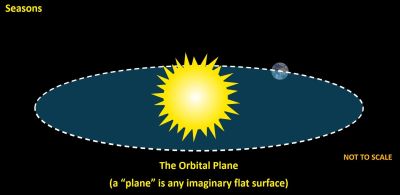 So, we know that the Earth orbits the Sun. The imaginary flat surface that the earth is on is called the orbital plane (a plane is any imaginary flat surface). The reason that the Earth experiences seasons comes down to the fact that the Earth’s axis, the imaginary line running from the North Pole to the South Pole, isn’t perpendicular (that is, at right angles) to the orbital plane but is tilted at an angle of 23.4°.
So, we know that the Earth orbits the Sun. The imaginary flat surface that the earth is on is called the orbital plane (a plane is any imaginary flat surface). The reason that the Earth experiences seasons comes down to the fact that the Earth’s axis, the imaginary line running from the North Pole to the South Pole, isn’t perpendicular (that is, at right angles) to the orbital plane but is tilted at an angle of 23.4°.
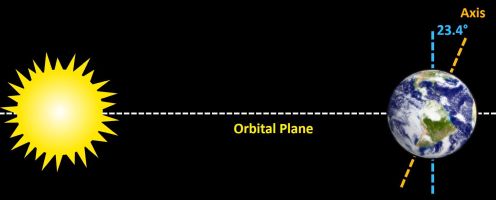
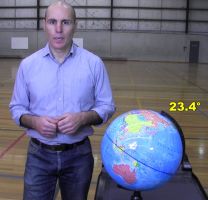
This 23.4° tilt of the Earth is the reason you’ll usually see globes tilted at this angle.
So the Earth moves around the Sun in a more-or-less circular path, it’s not exactly a circle but it’s fairly close, but, while it moves, it remains tilted at this angle of 23.4°.
Now the key thing here is that the tilt doesn’t change and the direction that the axis points also doesn’t change.


When the Earth is here, the axis is aligned like this and that’s the way it will stay. Three months later it’s still tilted in exactly the same way. Another three months later it’s the same, three months later it’s the same again and then three months after that (that is, a year later) it’s back to where it started. The reason that the axis direction stays the same is that the Earth is like a giant spinning top.
Now the Physics here is a little complicated, but, basically, when something is spinning it tends to keep the same orientation. Spinning tops seem to defy gravity, but they don’t really. So as the Earth moves around the Sun, it keeps the same orientation.
 So let’s get to the seasons. Seasons occur because of the tilt of the Earth. The tilt of the Earth as it orbits the Sun changes two things: firstly, throughout the year, the direction from which sunlight hits any particular part of the Earth changes and secondly the length of daytime that any particular part of the Earth experiences changes. Let’s look at the direction first.
So let’s get to the seasons. Seasons occur because of the tilt of the Earth. The tilt of the Earth as it orbits the Sun changes two things: firstly, throughout the year, the direction from which sunlight hits any particular part of the Earth changes and secondly the length of daytime that any particular part of the Earth experiences changes. Let’s look at the direction first.
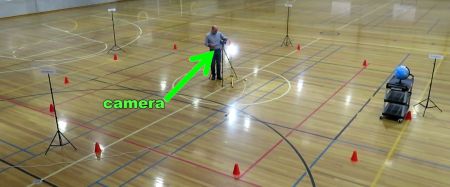
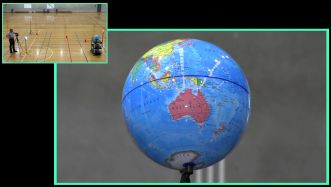
In December, the Earth is always in this position. Because of the tilt of the Earth, the Southern Hemisphere is kind of pointing towards the Sun and receives more direct light from the Sun, and so it gets heated by the Sun more than what the Northern Hemisphere does.
I can set up a camera here just behind the spotlight so that we can see what the Earth looks like in December from the Sun’s point of view. The Sun is shining more directly down onto the Southern hemisphere and so the Southern hemisphere is going to get a lot hotter than the Northern Hemisphere.
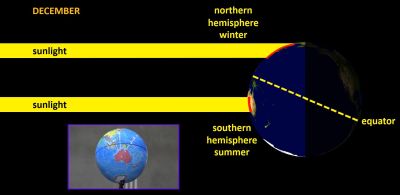 If we imagine a beam of sunlight with all its energy striking the Southern Hemisphere, the energy is concentrated in a small area which heats up a lot. Here the Southern Hemisphere is experiencing summer. An identical single beam of light striking the Northern Hemisphere at the same distance from the equator hits at an angle such that the energy spreads out over a wider area. That part of the Earth therefore doesn’t heat up as much. So in the Northern Hemisphere it’s winter.
If we imagine a beam of sunlight with all its energy striking the Southern Hemisphere, the energy is concentrated in a small area which heats up a lot. Here the Southern Hemisphere is experiencing summer. An identical single beam of light striking the Northern Hemisphere at the same distance from the equator hits at an angle such that the energy spreads out over a wider area. That part of the Earth therefore doesn’t heat up as much. So in the Northern Hemisphere it’s winter.
 Another way of looking at is to consider lots of sunlight hitting the Earth in this position. Most of the sunlight is hitting the Southern Hemisphere, so the Southern Hemisphere is obviously going to be warmer at this time of year.
Another way of looking at is to consider lots of sunlight hitting the Earth in this position. Most of the sunlight is hitting the Southern Hemisphere, so the Southern Hemisphere is obviously going to be warmer at this time of year.
Six months later, in June, the Earth has moved to the other side of the Sun but it keeps the same orientation.
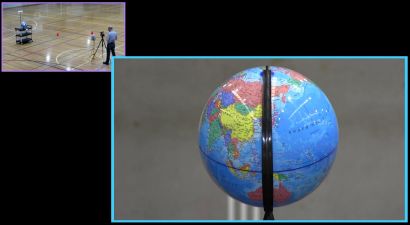
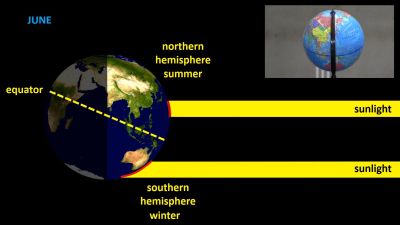
From the Sun’s point of view (as you can see, I’ve placed a camera back behind the spotlight which is our sun), the Earth now looks like this, with the Northern Hemisphere facing more towards the Sun, although obviously the real Earth is continuously rotating.
Now, the Sun is shining more directly onto the Northern Hemisphere so the Northern Hemisphere experiences summer while the Southern Hemisphere experiences winter.
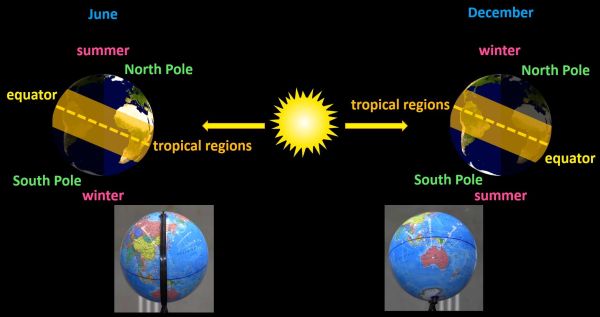 Now regions near the equator, which are called tropical regions, are hot all year round because of the more direct angle that the sun strikes those regions, and the poles are always cold once again because of the angle that sunlight strikes them.
Now regions near the equator, which are called tropical regions, are hot all year round because of the more direct angle that the sun strikes those regions, and the poles are always cold once again because of the angle that sunlight strikes them.
Summer and winter have nothing to do with the Earth’s distance from the Sun because the Earth moves around the Sun in more or less a circle. Rather, it’s the angle of the Earth with respect to the Sun that gives us summer and winter. More direct sunlight creates warmer weather while less direct sunlight creates cooler weather.
(If a scale model of the Sun was built to match this globe (that has a diameter of 32cm), it would have to be placed about 3.8 km away to accurately reflect the Sun-Earth distance.)
Between summer and winter we get autumn and spring. Let’s take a look.
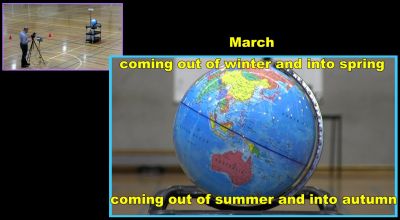 In March, the Earth moves a quarter of the way around its orbit to this position where neither of the two hemispheres is facing more to the Sun, so the weather is generally neither all that hot nor all that cold. It stays hot near the equator but just gets on average cooler and cooler the further from the equator you are.
In March, the Earth moves a quarter of the way around its orbit to this position where neither of the two hemispheres is facing more to the Sun, so the weather is generally neither all that hot nor all that cold. It stays hot near the equator but just gets on average cooler and cooler the further from the equator you are.
In this position, the Southern Hemisphere is coming out of summer and into autumn, while the Northern Hemisphere is coming out of winter and into spring.
If we do a half lap, passing June and getting to September, a similar situation arises. Neither hemisphere is facing the Sun more than the other. The Southern Hemisphere is coming out of winter and into spring while the Northern Hemisphere is coming out of summer and into autumn.
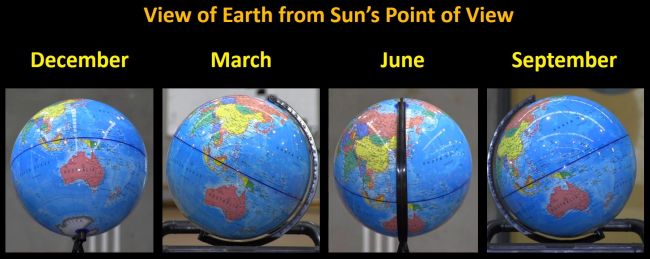
So, from the Sun’s point of view, the Earth’s looks kind of like these images at different times of the year. As I’ve said more direct sunlight creates warmer weather while less direct sunlight creates cooler weather.
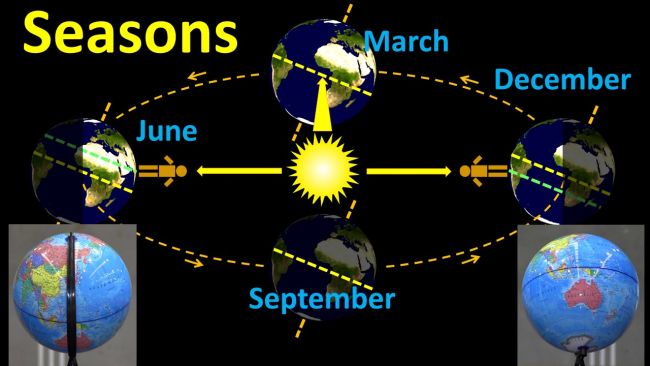
These four positions actually have names and they occur on more or less the same dates every year. The Earth is in this position on around December 21st every year. It’s called the summer solstice in the Southern Hemisphere and the winter solstice in the Northern Hemisphere, although it’s often simply called the December solstice to avoid confusion.
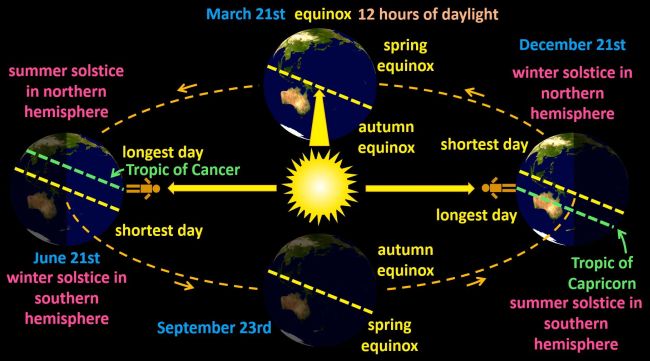
On the day of the December solstice, the sun is directly above what’s called the Tropic of Capricorn. The Tropic of Capricorn is marked on most globes. If you’re standing on the Tropic of Capricorn in the middle of the day on December 21st, the Sun will be directly overhead and you will be the closest person on Earth to the Sun! Having said that though, I’ll just repeat, summer and winter have nothing to do with how close you are to the Sun but rather it’s got to do with the tilt of the Earth and the direction from which sunlight hits it.
The day on which the December solstice occurs is the longest day of the year in the Southern Hemisphere, that is, it’s the day with the longest amount of daylight, and it’s the shortest day of the year in the Northern Hemisphere. I’ll explain why in a later episode.
Six months later, on around June 21st, the Earth is in this position, and it’s called the summer solstice in the Northern Hemisphere and the winter solstice in the Southern Hemisphere, or simply the June solstice to avoid confusion. This is typically the shortest day in the Southern Hemisphere and the longest day in the Northern Hemisphere. On this day, the Sun is directly above the Tropic of Cancer.
The Tropic of Cancer is as far north of the equator as the Tropic of Capricorn is south of the equator.
On around March 21st every year, the Earth is in this position. It’s called the equinox, the autumn equinox in the Southern Hemisphere and the spring equinox in the Northern Hemisphere and, quite often, the March equinox. The Sun is directly over the equator and no matter where you live, you’re going to have 12 hours of daytime and 12 hours of night time.
On around September 23rd every year, we get another equinox. Once again, there are 12 hours of daytime and 12 hours of night time and the Sun is directly over the equator (although I’m not really showing that in this animation, because of the angle that we’re looking at it from).
So, basically, the tilt of the Earth is responsible for the seasons because the way the Earth is orientated changes how directly the sunlight hits any given part of the Earth.
When the Northern Hemisphere is having summer (we filmed the beach scenes you’re watching in Greece in late June), the Southern Hemisphere is having winter. The snow scenes were filmed in the mountains just outside of Melbourne in July. All the seasons in fact are reversed in the two hemispheres!
And that’s it. Thanks for watching. See you next time.
CREDITS:
Written and Directed by Spiro Liacos.
Much of the content in this video was first published in Shedding Light on the Sun and Earth Episode 1: Seasons.
Star Wars Style March by Humanoide_Media
https://pixabay.com/music/main-title-star-wars-style-march-165111/
Invasion March – Star Wars Style Cinematic Music by Humanoide_Media
https://pixabay.com/music/main-title-invasion-march-star-wars-style-cinematic-music-219585/
Star-Wars-style opening crawl generated at the STAR WARS Intro Generator website: https://starwarsintrogenerator.com/



